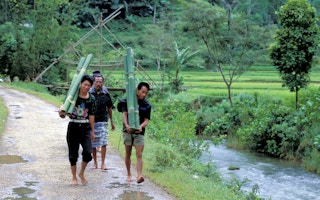Countries are fast ratifying the Paris Agreement on climate change, which entered into force on 4 November 2016. Now comes the implementation phase. We may have got here sooner than expected but now that we are here, we will need a massive scale-up of climate finance, including international funds, to deliver on our promises.
But if such funds are to address the vulnerabilities of those most in need, they must make their way effectively and efficiently down to the local level. Are they up to the task? The short answer is probably not.
Barriers and blockades
Nobody knows exactly how much climate finance reaches local people. Calculating a precise figure would require donors to disclose detailed information about how their finance flows within programmes and whether communities are involved in deciding how it is spent. Climate funds are simply not equipped to provide this level of transparency.
Working with the information available, the International Institute for Environment and Development’s (IIED) very rough estimate for 2003 to 2015 is that only 11 per cent of climate finance, or US$1.6 billion, flows to the local level.
So what is preventing finance from flowing to affected communities?
IIED’s analysis suggests it is a combination of factors, including the investment strategies of climate funds prioritising large-scale results; traditional financing intermediaries (eg. development banks) shying away from small-scale projects with higher transaction costs; risk-averse funding strategies; too little support for building local capacity to manage funds; co-financing requirements that hinder local ownership; and poor enforcement of policies for community engagement.
Promoting local finance in practice
And yet despite these barriers, there are both development and climate funds that reach communities and these prove local programmes can deliver a ‘triple-win’. Such programmes offer more sustainable results at lower costs, stronger local capacity, and climate-positive economic development benefits such as resilient livelihoods and clean energy.
Examples of such funds include the Global Environment Facility’s (GEF) Small Grants Programme, the World Bank’s Community-Driven Development, and the Department for International Development-supported County Climate Adaptation Funds in Kenya.
A close look at these examples reveals funding policies and practices that promote finance reaching the local level:
- Prioritising locally relevant results: funds that emphasise community-relevant interventions support more local projects. The results frameworks of the Adaptation Fund and Least Developed Countries Fund, for example, include indicators for resilience or vulnerability to climate change, which are measured at the household and community level
- Providing small-scale grants: individual grants of less than US$500,000 are more appropriate for local activities and the results of many small grants can deliver a big impact. The community-driven development approach of the World Bank has scaled-up its initiatives by aggregating projects – bringing together a number of implementers to deliver climate-positive development to communities at significant scale
- Grants or loans: the funds that reach the local level have used grants rather than loans to finance community-based projects, but there could be more experimentation with innovative financing. Whilst the Kenyan County Adaptation Funds have shown how to use grants to mobilise local public finance, the funds also need to innovate to unlock local private sector finance, for instance by using guarantees and equity investments
- Simple access and approval: some funds, such as the Forest Investment Programme, have designed simplified funding frameworks that make it easier to access funding for those with limited experience of doing so. This includes methods to overcome a lack of a fiduciary track record by, for example, facilitating site visits and third-party monitoring, as practiced by USAID, and
- Participatory funding structures: the best-performing funds, including the Forest Investment Programme and GEF Small Grants Programme, provide participatory funding structures. These enable local communities to design, appraise and evaluate climate-positive development projects themselves.
Six reforms to promote local finance
This week, parties to the United Nations Framework Convention on Climate Change will travel to Marrakesh, Morocco for their annual conference. One of the key themes will be the review of the donor’s roadmap towards achieving US$100 billion of climate finance annually by 2020.
Within that review, and the resulting guidance to funds that will materialise from COP22 in Marrakesh, negotiators should push for six architectural reforms that will increase the flow of climate finance to the local level:
- Identify the amount of financing that currently reaches the local level and involves community participatory processes
- Use that baseline to set an ambitious yet achievable goal for local financing
- Earmark flexible grant funding for local programmes within international funds
- Revise the policies of international funds to increase their risk appetite for supporting innovative financial instruments, be more flexible on co-financing, and use locally-relevant results frameworks
- Provide tailored capacity-building support to strengthen local capacity for managing climate funds, and
- Build national and local-level platforms for donors, governments, NGOs and representatives of those vulnerable to climate change to oversee and strengthen climate finance flows to the local level and ensure funding responds to the priorities of the poor to achieve climate-positive development.
Marek Soanes is a researcher in IIED’s Climate Change research group and Clare Shakya is the head of IIED’s Climate Change research group. This post was republished from the IIED blog.











